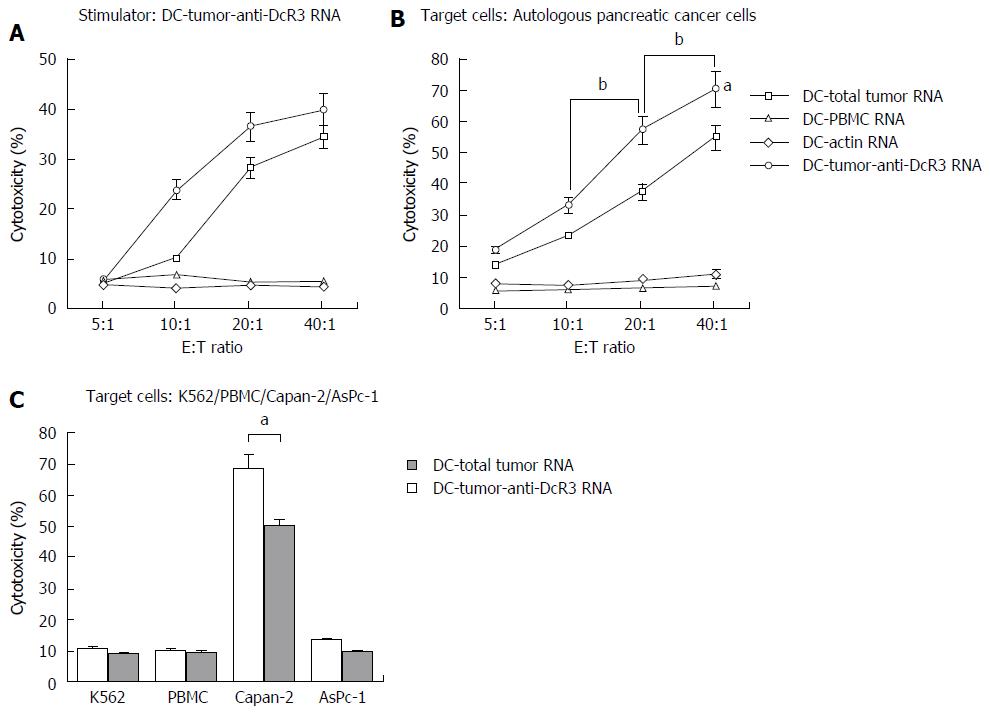Copyright
©The Author(s) 2017.
World J Gastroenterol. Feb 7, 2017; 23(5): 817-829
Published online Feb 7, 2017. doi: 10.3748/wjg.v23.i5.817
Published online Feb 7, 2017. doi: 10.3748/wjg.v23.i5.817
Figure 3 Antigen-specific immune response against pancreatic cancer is enhanced by anti-DcR3 monoclonal antibody secreting dendritic cell.
Dendritic cells (DCs)-total tumor RNA, DC-PBMC RNA, DC-actin RNA and DC-tumor-anti-DcR3 RNA were used to stimulate autologous T cells weekly for two times followed by a cytotoxic T lymphocyte (CTL) assay. Induction of tumor antigen-specific CTLs was measured by using RNA-transfected DCs and tumor targets (primary tumor cells, K562, Capan-2 and AsPC-1 cell line cells). A: Left panel: DC-tumor-anti-DcR3 RNA was used as not only stimulator cells but also target cells, and CTLs stimulated by DC-tumor-anti-DcR3 RNA could recognize and lyse tumor antigen-specific cancer targets (DC-total tumor RNA and DC-tumor-anti-DcR3 RNA). No cross-reactivity was apparent against DCs loaded with normal tissue surrounding PC or actin (DC-PBMC RNA and DC-actin RNA). Compared with CTLs stimulated by DC-total tumor RNA, DC-tumor-anti-DcR3 RNA further enhanced the induction of CTL activity. Right panel: Both DCs co-transfected with total tumor RNA and anti-DcR3 mAb mRNA and DCs transfected with total tumor RNA alone showed an effective and superior ability in recognizing and lysing HLA-A2+ autologous PC cells, whereas T cells activated by DC-PBMC RNA or DC-actin RNA could not (aP < 0.05). Moreover, CTLs induced by DC-tumor-anti-DcR3 RNA could produce a more powerful killing activity toward the tumor cells compared with the DC-total tumor RNA with the E:T ratio increasing from 10:1 to 40:1 (bP < 0.05); B: At the E:T ratio of 40:1, the effector T cells (HLA-A2+) stimulated by DCs transfected with total tumor RNA alone or together with anti-DcR3 mAb mRNA could lyse the Capan-2 cell line cells, which endogenously expressed the HLA-A2 antigen effectively. By contrast, the cells of the AsPC-1 line (HLA-A2-) were not recognized and lysed. DC-tumor-anti-DcR3 RNA showed a more powerful capability in inducing the cytotoxicity of CTLs against HLA-A2-matched tumor cell line (Capan-2) compared with that induced by DC-total tumor RNA alone (aP < 0.05). The experiment was repeated thrice representatively, and the data are shown as mean ± SD. mAb: Monoclonal antibody; DC: Dendritic cell; CTLs: Cytotoxic T lymphocytes.
- Citation: Chen J, Guo XZ, Li HY, Zhao JJ, Xu WD. Dendritic cells engineered to secrete anti-DcR3 antibody augment cytotoxic T lymphocyte response against pancreatic cancer in vitro. World J Gastroenterol 2017; 23(5): 817-829
- URL: https://www.wjgnet.com/1007-9327/full/v23/i5/817.htm
- DOI: https://dx.doi.org/10.3748/wjg.v23.i5.817









